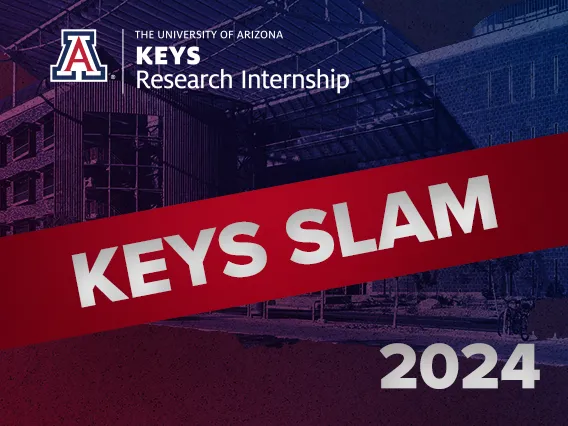2024 Alumni
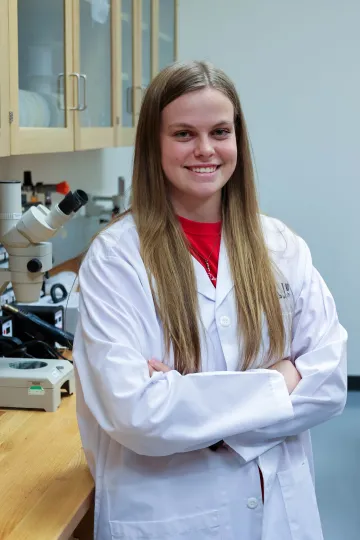
High School: Empire High School
City: Tucson
Faculty Mentor: Dr. Christopher Banek
Research Project: The Effect of Renal Innervation on the Progression of Polycystic Kidney Disease
Polycystic kidney disease (PKD) is an inheritable, incurable form of kidney dysfunction in which cysts form, causing kidney failure. I answered the question: is the progression of PKD slowed by the absence of nerves? I determined the effectiveness of renal denervation, or the removal of nerves from the kidneys, by measuring the amount of inflammation in treated and untreated kidneys. We hypothesize there to be little to no difference between the kidneys, indicating the presence of a hormonal irritant that could be accelerating the progression of the disease. Further research will involve halting the release of that hormone while watching for any complications. Research into this treatment brings us closer to slowing the progression of PKD with fewer side effects than current treatments.
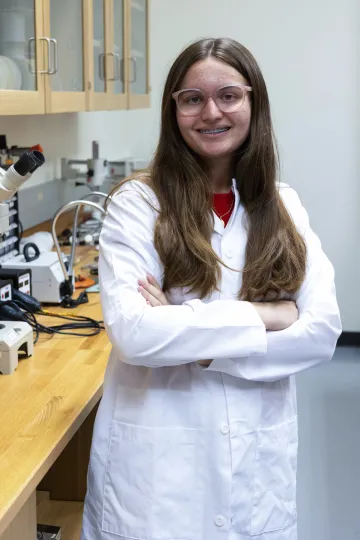
High School: Ironwood Ridge High School
City: Oro Valley
Faculty Mentor: Dr. Philipp Gutruf
Research Project: Stretching Stage Capabilities Testing and Material Stress-Strain Analysis for Medical Devices
The development of implantable and wearable devices for sensing and stimulation calls for careful scrutinization of material properties such as deformation behavior, relative strength and elasticity. This project identifies materials that optimize the performance of biomedical devices by analyzing stress-strain curves. These curves provide insight into a material's tensile strength, which defines the maximum stress the material can endure before fracturing, and its overall deformation trajectory. Specifically, we compared the stress-strain curves of several variations of a plastic, thermoplastic polyurethane (TPU), and its doped counterparts. We utilized the ESTIRA stretching stage and applied motorized strain to initiate fatigue loading onto the samples. We expect to obtain curves comparable to standard material literature and determine the suitability of a material based off of its elastic modulus.
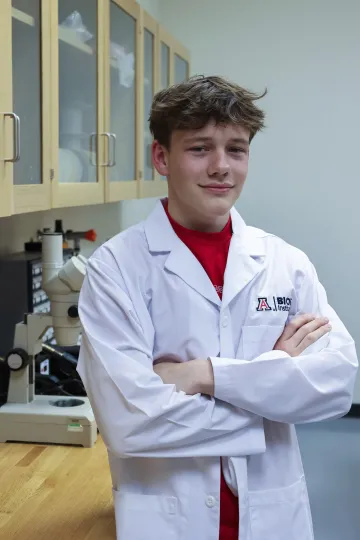
High School: American International School Chennai
City: Tucson
Faculty Mentor: Dr. Benjamin Renquist
Research Project: Endothelial Cells in Gamma-Aminobutyric Acid (GABA) Production
11.6% of Americans have type II diabetes, while 48.1% face hypertension. My project identified that endothelial (blood vessel) cells produce the neurotransmitter Gamma-Aminobutyric Acid (GABA), which inhibits nerve signals, causing type II diabetes and hypertension. To uncover endothelial cells’ role in GABA production, I collected liver samples exposed to chemical treatments that target two endothelial cell receptors. These treatments stimulated GABA release by decreasing cell membrane potential (the difference in electrical charge between cell interior and exterior). Conducting specialized tests, I identified GABA concentration increases, proving endothelial GABA production. With this finding, my lab may develop inhibitory drugs towards endothelial GABA release, treating diabetes and hypertension.

High School: Arizona College Preparatory High School
City: Gilbert
Faculty Mentor: Dr. Alicia Allen
Research Project: Investigating Recurring Themes within the Hopes and Wishes of Postpartum Mothers with Opioid Use Disorder for their Child
The prevalence of parents with Opioid Use Disorder (OUD) has increased by 600% in the past decade (Allen et. al., 2023), indicating a need for more research to improve interventional treatment methods among postpartum mothers with OUD. Prior research has revealed several factors that impact the mother-infant relationship among these mothers, but none have examined the impact of recurring themes within their maternal aspirations. By analyzing interview data from the ORCHID Study and conducting a literary search, my project investigates recurring themes within the hopes and wishes of these mothers for their children. I’ve concluded that the most prevalent themes within maternal aspirations are stability, happiness, health, love, and success. This research allows providers to create more caring interventional treatment methods for mothers with OUD.
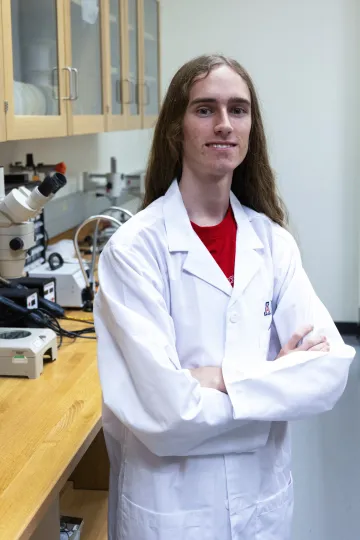
High School: Empire High School
City: Vail
Faculty Mentor: Dr. Ulises Ricoy
Research Project: Madagascar Hissing Cockroach Behavior in Social and Isolated Situations
Madagascar hissing cockroaches can be used as a low-budget insect model organism to study neural mechanisms (Ricoy, 2024). Due to a lack of research into this model organism, it can be hard to draw conclusions. My research focuses on creating a better understanding of how cockroaches behave in two different social environments. I did this by creating two groups, a Social Group, and an Isolated Group. I observed these two groups of six roaches over two weeks; one group contained all six in one terrarium, and the second put each in a separate terrarium. By analyzing their behavior using machine learning. I hope to see differences in behavior between the two groups and use this as a starting point for future research.

High School: Catalina Foothills High School
City: Tucson
Faculty Mentor: Dr. Haining Zhu
Research Project: Investigating the Effects of G3BP-1, PID1, EMID1 Across A375, HaCaT, and U2-OS Cell Types
Dr. Zhu’s lab contributes to cancer research by investigating the relationship between stress granules, cancer, and other neurodegenerative diseases. Stress granules occur under stressful conditions. Occasionally cells are unable to disassemble stress granules; this can potentially lead to harmful consequences. The goal of my research is to use lentiviral gene modification across 3 different human cell types to knock out 3 key proteins important to stress response to study the effects their absence has on stress granule formation and potential influence on the expression of other proteins. Without further analysis it's difficult to draw conclusions currently, our data suggests that we may have knocked out one of the three proteins. This research can aid the development of therapeutic treatments to combat stress granule growth.
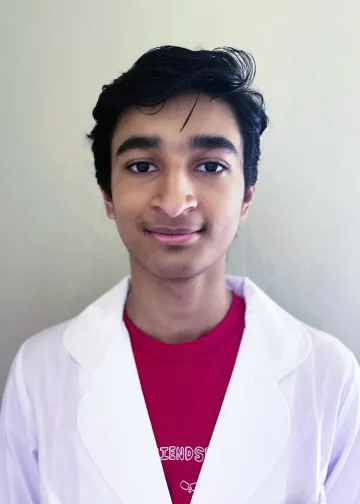
High School: ASU Prep Digital
City: Yuma
Faculty Mentor: Dr. Ryan Gutenkunst
Research Project: Inferring the Evolutionary History of Two Midas Cichlid Fish Species
Cichlid fish are known for their rapid diversification, making them ideal for studying evolution and the formation of new species. We investigated the evolutionary history of two Midas cichlid species by analyzing changes in their population sizes, migration events, and the influence of mutations on their survival. Our general method involved analyzing the species’ genetic data using the dadi software to infer likely scenarios. We found that these two species became distinct recently, with the presence of ongoing migration. Furthermore, the impact of new mutations on survival was nearly identical between them. This research enhances our understanding of cichlid evolution and can inform their conservation strategies through a better understanding of their genetics.

High School: Mica Mountain High School
City: Tucson
Faculty Mentor: Dr. Michael Brown
Research Project: Role of Bound Water on Visual Receptors
G-protein-coupled receptors (GPCRs) are membrane proteins that relay external signals intracellularly to regulate various functions in the body. However, their malfunction leads to countless diseases. The Brown Lab is investigating rhodopsin, a prototypical GPCR that detects light allowing for dim-light vision; understanding its activation mechanism will aid in refining drug treatments. I explored bound water’s influence on the light absorption of rhodopsin. Using a computational approach, we ran calculations on differing amounts of water molecules surrounding rhodopsin’s light absorbing molecule and ten amino acid residues. Results showed that adding more water molecules around rhodopsin stabilizes its structure and shifts its light absorbance to a shorter wavelength. We concluded that water plays a key role in rhodopsin activation which may help advance future drug designs.
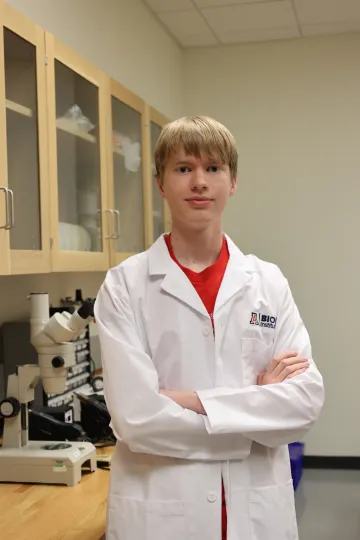
High School: Catalina Foothills High School
City: Tucson
Faculty Mentor: Dr. Brian LeRoy
Research Project: Testing the Unique Electrical Properties of Graphene
Graphene is a material made of carbon that is one atom thick. The project's goal was to assess how creating electrical devices could help test the unique properties that occur with two sheets of rotated graphene stacked on top of each other to form a super-structure. Using the device at ultra-low temperatures, the conductivity of the graphene bilayer was measured at different magnetic fields and voltages. Responding to changes in the magnetic field, only certain values of conductance become possible. These values are reliable, precise, and present regardless of material imperfections. These properties of graphene make it a promising material for a wide range of advanced technology ranging from highly accurate sensing technology to quantum computing.

High School: The Gregory School
City: Tucson
Faculty Mentor: Dr. Michael Taylor
Research Project: Investigation of Mitochondrial Transition Pore Components With Pyridinium Cyclosporin A
Mitochondria Permeability Transition Pores (MPTPs) assist in mitochondrial functions. However, irreversible openings lead to abnormalities and various cardiovascular diseases. My project focused on modifying proteins to identify the unknown components of these pores. To do so, I ran two experiments with a probe containing a ligand and one without to visualize the enrichment of the probe to the proteins.We hypothesized that we will see less signaling using the ligand. Current imaging results show the probe without the ligand has a positive dosage response and is effective at labeling general proteins. In future research, we will perform live cell experiments and use confocal microscopy to observe our probe’s localization to MPTPs. This will be fundamental in creating better treatment against MPTP-related diseases.

High School: Sahuaro High School
City: Tucson
Faculty Mentor: Dr. Erika Eggers
Research Project: Do CaV1.3 Calcium Channels Change in the Retina after 6 Weeks of Diabetes?
Over 35% of people living with diabetes end up with diabetic retinopathy (vision loss) (Yang 2012). My research will examine the change in quantity and relative distribution of the calcium channel CaV1.3, and two types of amacrine cells (neurons in the retina) of diabetic and non- diabetic retinas. I used immunostained retina slices (5 diabetic and 5 non-diabetic) to quantify the occupied areas that include the amacrine cells and CaV1.3, as well as the area that includes CaV1.3 overlapping both amacrine cells in specific layers. My research shows that the levels and distribution of CaV1.3 in the two types of amacrine cells do not change in diabetic retinas. Further research will use electrophysiology to test if blocking CaV1.3 channels affects diabetic and non-diabetic retinas differently.

High School: Paradise Valley High School
City: Scottsdale
Faculty Mentor: Nirav Merchant
Research Project: Streamlining Metadata Management and Dataset Migration
Efficient data management is vital for scientific research collaboration, sharing, and accessibility. This project enhances dataset management by migrating datasets to a more accessible platform, standardizing metadata, and improving storage efficiency. First, I created a program to access and migrate datasets, making them publicly accessible. Second, another program converts certain files into a different file format which requires less storage space while maintaining accuracy. Additionally, the project includes converting datasets to different metadata formats, improving data interoperability. Finally, I developed a user interface to allow researchers to easily manage datasets, integrating all functionalities into one accessible platform. Future work should address the limitations related to this project such as conducting extensive testing and validation as well as allowing for the use of more data platforms.
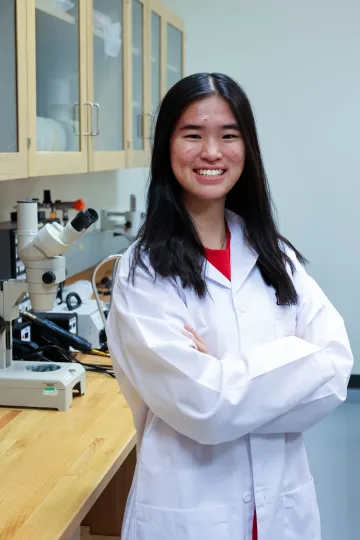
High School: Hamilton High School
City: Chandler
Faculty Mentor: Dr. Jennifer Barton
Research Project: Mapping the Stiffness of Ex Vivo Mouse Mammary Tissue Samples Using Optical Coherence Elastography For Early Cancer Detection
Tissue stiffness may act as a predictor of cancer, with stiffer tumors associated with being more malignant. This project uses a technique called optical coherence elastography (OCE) to map tissue stiffness, comparing soft- and stiff-conditioned tumors. For each tumor type, we compressed the specimen with a phantom, a transparent silicon layer. The resulting deformation (strain) of the phantom provides relative measurements of tissue stiffness, which were visualized in a colormap overlaid onto the original tissue images. The maps are able to identify the stiff and soft areas of the tissue and show a higher tissue stiffness in the stiff-conditioned tumor. This demonstrates the feasibility of using OCE to measure tissue stiffness to further characterize regions of interest and improve accuracy for early detection of cancer.

High School: BASIS Chandler
City: Chandler
Faculty Mentor: Dr. Shang Song
Research Project: Synthesis of a Micropatterned Conductive Composite Hydrogel to Probe Cellular Response
Traditional cell culture substrates have furthered the study of cell behavior, but do not fully encapsulate the extracellular environment. Consequently, biocompatible hydrogels which more accurately simulate the native microenvironment have been developed. Hydrogels are water-based solids formed by crosslinking polymers in a 3-dimensional matrix structure. With tunable properties such as surface chemistry, electrical stimulation, or topography, they can mimic various conditions that influence cell behavior. This project leverages knowledge of biology, chemistry, and engineering to optimize the properties of a gelatin-based conductive hydrogel. To manipulate topography, gels with sub-10 micron features were synthesized using a silicon pattern template. With optimal conductivity and cell adhesion to the patterns, this gel holds promise as a culture substrate to engineer in vitro tissues to counter debilitating nervous injuries.
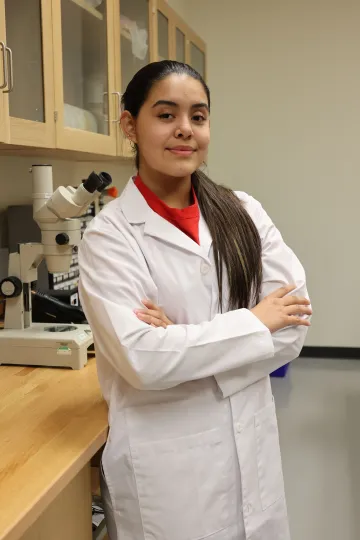
High School: Salpointe Catholic High school
City: Tucson
Faculty Mentor: Dr. George Sutphin
Research Project: The Effects of Fasting Conditions on Cancer Breast Cell Prior to Tamoxifen Treatment
Breast cancer is one of the most common cancers, particularly affecting women. Current treatments like chemotherapy and Tamoxifen are effective but harm healthy cells alongside cancerous ones. Developing therapies that specifically target malignant cells is crucial. In my lab, we investigated whether starvation conditions made cancer cells more vulnerable to cancer treatments or not. We found that starved cancer cells showed increased sensitivity to Tamoxifen compared to normal cells. This sensitivity is linked to Differential Stress Response, referring to increased cancer cell susceptibility while enhancing normal cells' resistance to the Tamoxifen, which is induced by starvation. This research can apply for future use of trying to find targeted therapies for cancer.

High School: Tanque Verde High School
City: Tucson
Faculty Mentor: Dr. Renee Duckworth
Research Project: How Compatibility Impacts Reproductive Success in Zebra Finches
Zebra finches are a monogamous species of songbird that form pair bonds. The objective of this study was to examine how a couple’s level of compatibility influences reproductive success. This is determined by how many offspring the couples have, and how many reach adulthood. Compatibility is measured by surveying behaviors such as allopreening, eating together, and behavioral synchrony. To measure the pair’s bond, we observed recordings of their interactions and used a score sheet to record how often these behaviors occurred.
We predict that female preference will have a positive correlation to how compatibility is expressed and how it will positively affect reproductive fitness. This research will benefit conservation programs and help researchers understand complex social networks in birds.
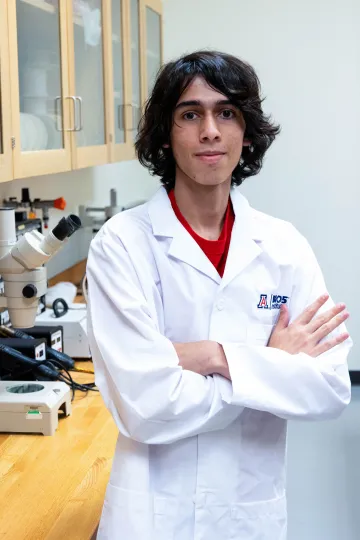
High School: BASIS Tucson North
City: Tucson
Faculty Mentor: Dr. John Schaibley
Research Project: Altering the Resistance of Single-Atom Thick Graphene Using Chiral Molecules to Replace Magnetic Fields
Nanomaterials have great potential in improving the efficiency of electronics, which currently waste tons of energy in wires. Superconductors have the potential to nearly eliminate this energy loss. One way to make a superconductor is through the Hall Effect by placing a magnet near a material to change its resistance. We wanted to see if this magnet could be replaced with spiral-shaped (chiral) molecules in single-atom thick graphene. After creating graphene samples by peeling them off graphite with scotch tape and adding gold contacts so we could attach wires, we applied a magnetic field and measured the current. We hope to see the chiral molecules act as an extra magnetic field. If successful, it may be possible to make practical superconductors using this setup.
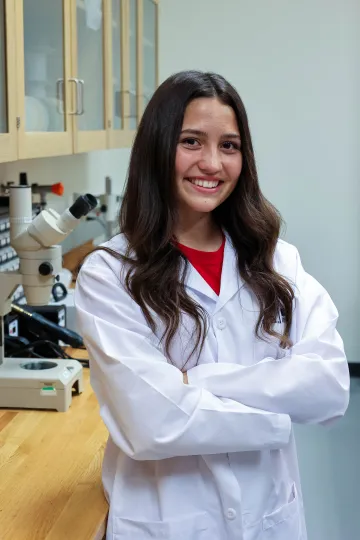
High School: Gilbert Classical Academy
City: Gilbert
Faculty Mentor: Dr. Shaowen Bao
Research Project: Noise-Induced Fear Conditioning and Microglial Activation in the Basolateral Amygdala
Dr. Shaowen Bao’s neuroscience lab investigates how noise exposure and hearing loss affects the brain. My project focused on changes in the amygdala, the brain area responsible for fear detection. After studying their behavior, we observed that mice exhibited increased anxiety and fear, indicated by their preference for corners, following hearing loss. At the cellular level, we used microscopic imaging to study microglia, the brain’s immune cells, and found that their number and soma size increased after noise exposure. This suggests that hearing loss activates microglia and contributes to heightened fear and anxiety. Our findings suggest that future research may be able to target microglia to treat cognitive disorders, such as anxiety and fear conditions associated with hearing loss.

High School: Tanque Verde High School
City: Tucson
Faculty Mentor: Dr. Nikolay Golubev
Research Project: Creating Interactive Model of High Harmonic Generation
High Harmonic Generation (HHG) is a process where the potential energy of an atom adopts the motion of the laser field, allowing an electron to escape from the atom and occasionally return. This process is an essential part of attosecond physics (physics on an extremely short timescale) because it allows the generation of quick attosecond (10⁻¹⁸ of a second) light pulses which can be used to observe electron dynamics. My project focused on creating an interactive computer simulation which would help teach students about HHG. This involved writing code that uses equations to relate leaving time with displacement, and then graphing the results. Using this software, students will be able to manipulate the time of the electron leaving and visually see the corresponding electron trajectory.
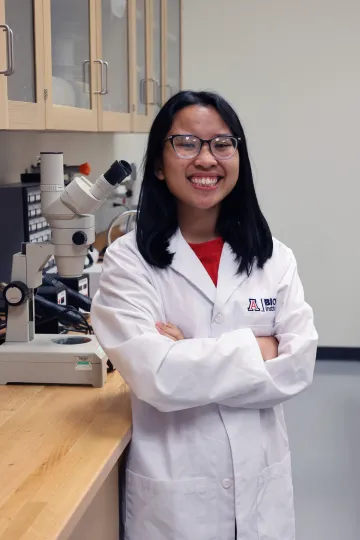
High School: BASIS Tucson North
City: Tucson
Faculty Mentor: Dr. Laura Meredith
Research Project: Volatile Organic Compounds Variations Among Different Sorghum Genotypes in Semi-Arid Agroecosystems
As climate change and food insecurity grow, predicting crop productivity through environmental analysis holds transformative potential for agriculture. I investigated the volatile organic compounds (VOCs) emitted by the roots of five sorghum genotypes, a grain crop, to explore their relationship with plant productivity. My focus was that VOCs, evaporative chemicals produced by plants, were hypothesized to be more diverse and concentrated in the more productive sorghum genotypes. To test this hypothesis, VOCs were collected using an underground soil probe and purified. My current research indicates a positive trend between VOC concentration and sorghum productivity, with more productive plants in the day showing higher concentrations of diverse VOCs. Future research aims to identify more VOCs from the five sorghum genotypes, enhancing our understanding of plant productivity.
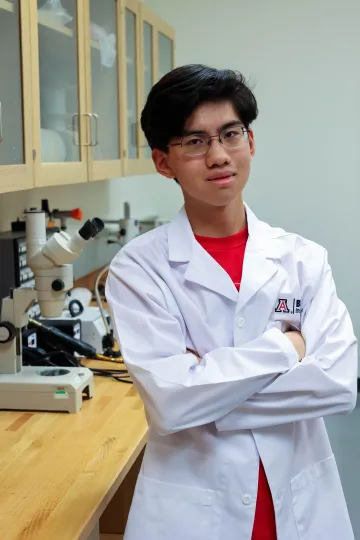
High School: BASIS Flagstaff
City: Flagstaff
Faculty Mentor: Dr. Ashley Snider
Research Project: The Effect of Different High-Fat Diets on Sphingolipid Generation within the Colon
Sphingolipids are bioactive lipids involved in cellular messaging throughout the body and are impacted by dietary fat intake. Our goal was to understand how different high-fat diets and loss of key sphingolipid enzymes, i.e. Ceramide Synthases (CerS) 5/6, impact sphingolipid generation in the colon. Lipids were extracted from colonic tissue and analyzed by mass spectrometry. Lard-based diets had the greatest trend in impacting sphingolipid species, particularly in knockout females. Knockout of CerS5/6 lowered C14:0 and C16:0-Ceramide in all diets. The findings from this research will help further our understanding of how commonly consumed foods regulate biological functions and contribute to the emerging field of lipid cell messaging.
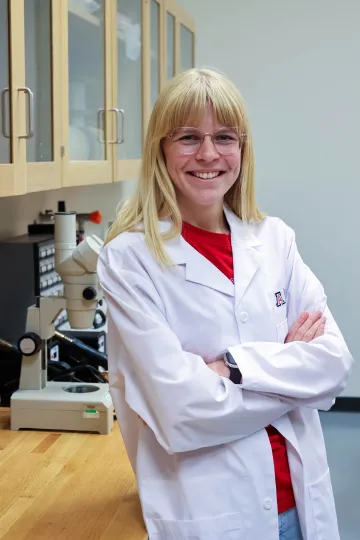
High School: Tanque Verde High School
City: Tucson
Faculty Mentor: Dr. Pascal Charest
Research Project: Determining the Relationship Between PI3K and RAS-Mediated mTORC2 Activity
Previous research suggests two proteins, RAS and mTORC2, promote migration and invasion of breast cancer cells. The same research suggests an additional protein PI3K may be involved in mTORC2 regulation1. We sought to determine if there is independence between RAS-dependent mTORC2 activity and PI3K. We utilized 2 cell lines: a control and one with an overexpression of RAS. We expect an increase in RAS will lead to an increase in mTORC2 and RAS-mTORC2 activity has an independent relationship with PI3K. This research will help form an understanding of cell migration which is essential to understanding cancer metastasis, the migration of cancerous cells away from their original tumor site.

High School: Pueblo Magnet High School
City: Tucson
Faculty Mentor: Dr. Minkyu Kim
Research Project: Recombinant Keratin Synthesis for Prosthetic Coating for Long Term Use
Prosthetics and skin have different mechanical properties which is why they don't bind well, causing the “Foreign Body Reaction”(FBR)1 where the skin rejects foreign objects. However, skin and nails also have mechanical differences, yet they bind very well to each other. This is because both our skin and nails contain Keratin, which is found in wool, hair, skin, and fingernails .Our team came up with the question, “What if we coat prosthetics in Keratin?” We theorized that by coating prosthetics in Keratin, it would increase compatibility of skin and prosthetics. We successfully extracted Keratin and it is (now) ready for use. Testing Keratin with prosthetics will be important in finding a way to make prosthetics more compatible with human skin and avoiding the FBR.
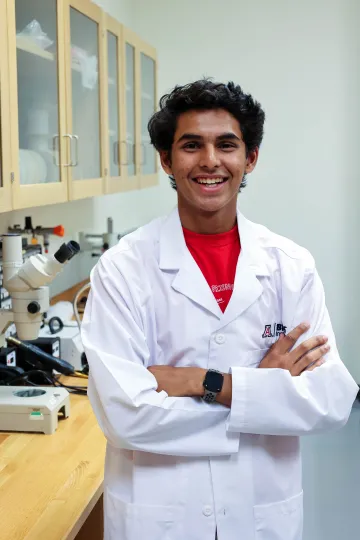
High School: BASIS Tucson North
City: Tucson
Faculty Mentor: Dr. Russell Witte
Research Project: Developing a Brain Model for Acoustoelectric Imaging
Healthcare professionals turn to imaging systems that allow for visualization of brain activity. However, modern imaging systems are vastly limited in their spatial and temporal capabilities which incites a need for a clearer, more accessible imaging system. My research focused on developing an experimental head model to emulate brain tissue properties and study an acoustoelectric imaging system. We compared the acoustoelectric properties of the experimental phantom to the model generally used by the lab. We expect to find that the experimental phantom has similar properties as the general lab model and will thus be a viable model for future acoustoelectric studies which could yield a noninvasive imaging technique capable of addressing neurological disorders such as localizing and treating seizures.
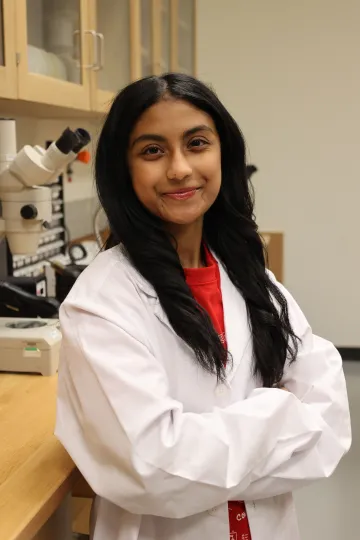
High School: BASIS Oro Valley
City: Tucson
Faculty Mentor: Dr. Alicia Allen
Research Project: Coping Strategies for Opioid Use Disorders during Week 1 of Postpartum
Opioid Use Disorder (OUD) is one of the most prevalent and hardest substance use disorders to overcome among pregnant women with relapse rates from 30 to 70% (Health Research Board, n.d.). To prevent relapse, many interventions are put into place, but most are not readily accessible nor affordable. This is why I qualitatively analyzed coping mechanisms used by pregnant, OUD mothers to overcome cravings during their first week of postpartum. I thematically organized their responses, thus allowing me to identify the major themes: spending time with their baby, staying busy, finding a distraction, and having support groups or counseling. For future research, we can see how coping mechanisms changed overtime during the postpartum period or how to assign specific cravings to a specific drug.

High School: BASIS Phoenix High School
City: Phoenix
Faculty Mentor: Dr. Gondy Leroy
Research Project: Using the All Of Us Database to Examine Neurotrauma and Abuse of the Elderly Population
This study investigates neurotrauma and abuse among adults, with a specific focus on traumatic brain injury (TBI), nontraumatic brain injury (nTBI), and concussion. My objective was to analyze demographic patterns and look for signs of elderly abuse using the All Of Us database, which contains the electronic health records of thousands of Americans. My findings revealed that women and African Americans were significantly more likely to undergo neurotrauma and abuse. I also found that out of all adults affected, more than 11% were elderly. This research is crucial as it sheds light on the abuse existent in our society.

High School: BASIS Scottsdale
City: Scottsdale
Faculty Mentor: Haijaing Cai
Research Project: Cracking the Brain's Hunger Code: Central Amygdala's PKC-δ+ Neurons’ Role in Amphetamine-Induced Anorexia
When amphetamines are taken it causes a loss of appetite or suppression of eating. I specifically focused on the Central Amygdala, a region that controls eating behavior. My project was focused on a specific population of neurons in the Central Amygdala known as the PKC-δ neurons, and how amphetamines can increase the activation of these neurons leading to a suppression of eating. I performed an image analysis on mice brains treated with both saline and amphetamines, and observed the amount of activation of the neurons of interest. Our findings demonstrated that amphetamines increased activation of the neurons of interest. These findings can be useful for further understanding of the Central Amygdala and for specific targets for treatments of obesity and Prader-Willi Syndrome.
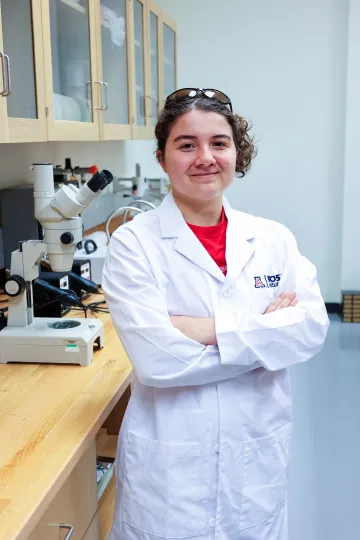
High School: The Gregory School
City: Tucson
Faculty Mentor: Dr. Anita Koshy
Research Project: What Effect Does Removing the TLO Gene Have on Toxoplasma gondii?
Toxoplasma gondii, an intracellular parasite, infects ~30% of the population and transforms from a quickly replicating stage to a dormant stage, forming cysts (Bradyzoite stage), which causes chronic infection. My research focuses on the TLO gene, a potential protein to Bradyzoites, and what effect the removal of TLO has on T. gondii’s ability to form and maintain cysts in neurons. We measured the immune response in a mouse’s brain: a smaller immune response would mean that the parasite did not even make it to the brain, but a larger immune response would show a lack of ability to form cysts. Learning about T. gondii’s ability to change stages and what causes it will help future research on preventing chronic Toxoplasmosis.
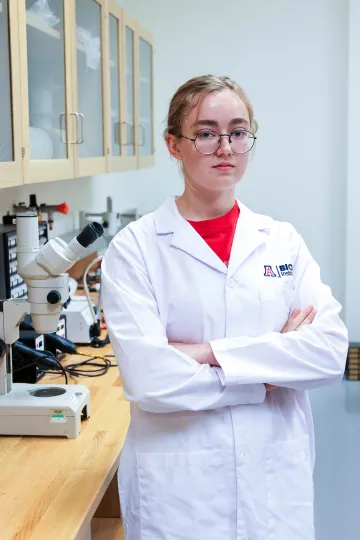
High School: Tanque Verde High School
City: Tucson
Faculty Mentor: Dr. Mohammed Hassan
Research Project: Temporal Characterization of Ultrafast Laser Pulses
Ultrafast Electron Microscopy, a method for imaging electron movement, depends on precise measurements of extremely short laser pulses. The purpose of my research is to determine the temporal duration of these laser pulses. One optical technique is Frequency Resolved Optical Gating (FROG). The FROG technique ultimately combines two pulses in a non-linear crystal, which creates a single “signal” pulse. A spectrogram (FROG trace) plots the wavelength of the signal pulse versus the time delay. Through software analysis of the FROG trace, I determined the laser pulse was approximately 5-10 femtoseconds (10-15), which is the precision of a few quadrillionths of a second. FROG analysis can be used to improve the implementation of electron imaging and further our understanding of electron dynamics.
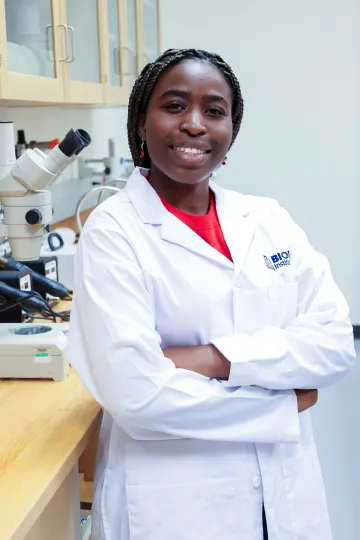
High School: Sahuaro High School
City: Tucson
Faculty Mentor: Dr. Jacob Schwartz
Research Project: The Role of Cytoskeleton Non-coding RNA in Ewing Sarcoma
Understanding the role of certain non-coding RNAs is crucial for insights into Ewing Sarcoma, a rare and aggressive bone cancer affecting children and adolescents. This study focused on Cytoskeleton Regulator RNA (CYTOR lncRNA), which regulates gene activity and influences cell growth, HIV latency, and cancer development. We aimed to identify its presence in Ewing Sarcoma cells and explore its potential role. We culture Jurkat cells (T cells) as controls and A673 wild type cells (Ewing Sarcoma cells) and conducted a quantitative PCR on relevant primers to test our hypothesis. The qPCR results indicated a reasonable amplification of the primers in both cell lines, suggesting the presence of CYTOR in Ewing Sarcoma. Future research will study its role in the development and relapse of bone cancer.
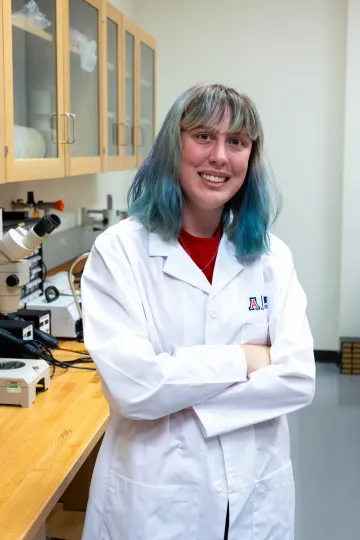
High School: Tanque Verde High School
City: Tucson
Faculty Mentor: Dr. Michael Brown
Research Project: How Structural Water Influences Visual Receptors
Rhodopsin, which is responsible for dim-light vision, is a model protein used to investigate the properties of 800+ related G-Protein Coupled Receptors (GPCRs). My specific research is looking into how water molecules interact with Rhodopsin before it’s been activated. To do this, we isolated one section and added different amounts of water molecules around it, and ran simulations to get spectrums of when it absorbed the most light. We found that all trials absorbed the most light at around 500 nm, and all trials containing more than 4 water molecules contained a smaller peak at around 380 nm. These results can give researchers more insight into how GPCRs function as a whole, and allow companies developing GPCR targeting drugs to make them more effective.
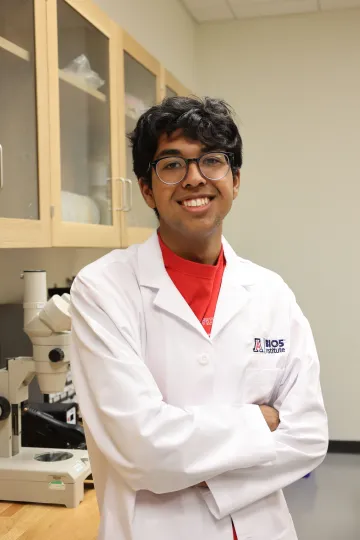
High School: Catalina Foothills High School
City: Tucson
Faculty Mentor: Dr. Thomas Gianetti
Research Project: Synthesizing Organic Photocatalysts Using Carbenium Ions and Tridente Pendant Arms
Photocatalysts, chemicals that speed up reactions, are used everywhere, from Solar Panels to water filters; however, modern photocatalysts rely heavily on harsh chemicals that react in undesirable ways. My project aimed to synthesize an organic photocatalyst alternative that is affordable, non-toxic, and only participates in desirable reactions. This is made using a symmetrical molecule known as a carbocation, which is modified with chemical chains that attach to the molecule. These chains, called pendant arms, allow us to bind metals to the carbocation and make it function as a catalyst. Since it’s difficult to synthesize these molecules, an NMR machine verifies if the structure is correct. If our research is successful, we will be left with a photocatalyst superior to modern alternatives by nearly every metric.
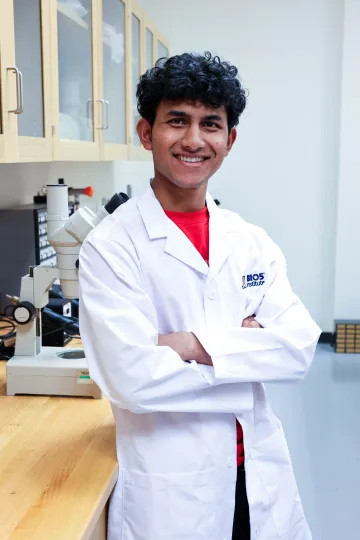
High School: Arizona College Preparatory High School
City: Gilbert
Faculty Mentor: Dr. Tally Largent-Milnes
Research Project: Analyzing the Potential of Concentrations of Sumatriptan to Induce Medication Overuse Headache in Male Rats
Migraines are among the most prevalent neurological disorders, often requiring medications such as triptans. However, overuse can result in Medication Overuse Headaches (MOHs) as a side effect. Both potentially stem from deficiency of endocannabinoids such as 2-AG, molecules that regulate pain in the nervous system. 2-AG’s absence and degradation can result in excess neuron activity and inflammation. Our study focused on determining if migraine medication sumatriptan induces MOH. Using male rat models, we implanted 2 concentrations of sumatriptan and saw if they showed a response to usually non-painful stimuli, an indicator of MOH. We expect to see higher concentrations of sumatriptan inducing more MOH. Our research would clarify sex differences in MOH, and future work aims to reverse and prevent MOH by inhibiting 2-AG degradation.
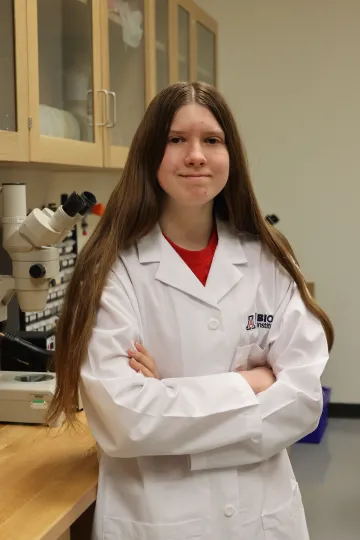
High School: University High School
City: Tucson
Faculty Mentor: Dr. Daniel Papaj
Research Project: Bee Color Perception and Changes in Palo Verde Flower Reflectance Over Time
Flower color plays a major role in attracting pollinators. Some flowers, like palo verde flowers, have a prominent petal called the banner petal that often changes color after pollination. We studied flowers from Mexican palo verdes and Desert Museum hybrids to better understand changes in flower color. We also investigated whether bees can differentiate newer and older flowers. We measured light reflectance and wavelength of each petal type and compared the colors in bee color space. We found that bees can detect a significant difference between new and old banner petals. Banner color differences benefit both the bee and the plant by increasing the efficiency of pollen transfer and nectar collection. Understanding bee perception and its relation to pollination could be vital in protecting ecosystems.

High School: Arizona College Prep High School
City: Chandler
Faculty Mentor: Dr. George Sutphin
Research Project: Effects of Dietary Cholesterol on Lifespan of C. elegans
Aging is studied worldwide due to the prevalence of age-related diseases. Previous experiments have shown excess dietary cholesterol increases lifespan in C. elegans, microscopic worms. My lab investigated the effect of cholesterol metabolism on their lifespan to later apply this knowledge to humans. We tracked the survival of the worms under different living conditions, normal cholesterol and excess cholesterol, to create lifespan curves. By feeding them fluorescent cholesterol, we are able to image the distribution of the compound within their bodies. We found the fluorescence was more localized in internal body parts of the cholesterol group. Understanding that excess cholesterol is trafficked to specific regions will help narrow down which bodily regions are linked to aging, setting a foundation for future research.

High School: University High School
City: Tucson
Faculty Mentor: Dr. Guang Yao
Research Project: Investigating Nrf1 Activation from Nutrient Deprivation
According to the World Health Organization, cardiovascular diseases (CVDs) kill almost 18 million people annually. Nrf1is a cardioprotective reparative protein, vital for future treatments. My research project asked: Can nutrient deprivation increase active Nrf1 levels for increased cardio protection? We grew and starved rat embryonic tissue cells and ran a Western blot. Our results showed mostly bands of activated Nrf1 with gradual increases in thickness for increased starvation periods, indicating higher levels of activated Nrf1 for starved cells with some differences across band sizes. Confirming the relationship between starvation and Nrf1 levels in rat cells allows for future research with heart cells, furthering understanding of specific starvation conditions of Nrf1 activation and contributing to the development of future treatments using it to combat CVDs.
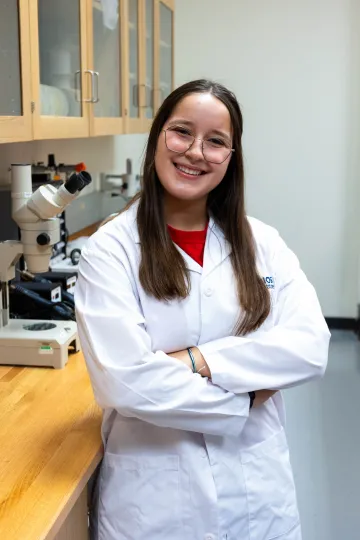
High School: Millennium High School
City: Litchfield
Faculty Mentor: Dr. Andrea Achilli
Research Project: Inactivation of Virus Using Salicylic Acid and Conventional Wastewater Treatment Technologies
Decontamination methods are needed for safety and sustainability. I investigated the use of salicylic acid as an ingredient in sanitizers. I conducted plaque assays on viruses to determine virus recovery after exposure to salicylic acid. I found that 0.2% and 0.3% salicylic acid would be optimal concentrations for synergistic experiments with PhiX virus and 0.1% acid would be the optimal concentration for synergistic experiments with MS-2 virus. Furthermore, I was introduced to conventional wastewater treatment technologies and ran experiments using granulated activated carbon (GAC) for chlorine removal. Chlorine can react with organic contaminants to form carcinogens. I added GAC and catalytic GAC to chlorinated wastewater and calculated the chlorine removal rate. I found that catalyzed CGAC was 26% more effective than GAC.

High School: Gilbert Classical Academy
City: Gilbert
Faculty Mentor: Dr. Haiquan Li
Research Project: Object Detection and Automatic Segmentation Model for Weed Detection in Lettuce Farms
Weed infestations cause $32 billion of loss every year and destroy natural habitats (Beck & Wanstall, 2021; Kubiak et al., 2022). To solve this problem, I created a machine learning model that detects weeds in lettuce farms. I annotated many images, which were fed through a training code. Then, the model was tested on 30 images. It performed well with a 0.78 out of 1 on the Mean Average Precision test, an analysis for rating a model’s prediction ability. This research will not only help lettuce farmers detect weeds automatically and increase agricultural yield, but with weeds’ outline, herbicides can also be sprayed more efficiently and their environmental harm can decrease. Additionally, this research can decrease the production cost, which will lower lettuce prices.

High School: Basis Scottsdale
City: Scottsdale
Faculty Mentor: Dr. Tyson Swetnam
Research Project: Developing, Implementing, and Testing Reproducible AI Chatbots in Research and Educational Applications
AI is transforming our world at an unprecedented rate. My project focused on developing a ChatGPT-4o based assistant with research and educational applications. This chatbot access files from a source to update its knowledge at a set interval. Currently the chatbot is being deployed on CyVerse Data Commons, a platform where researchers around the world store their data. The chatbot aims to help curious individuals better comprehend complex datasets. To ensure all responses are accurate, this assistant cites all referenced material via hyperlinks to specific web pages where data is stored. This will help researchers streamline their analysis process by providing accurate data driven insights.
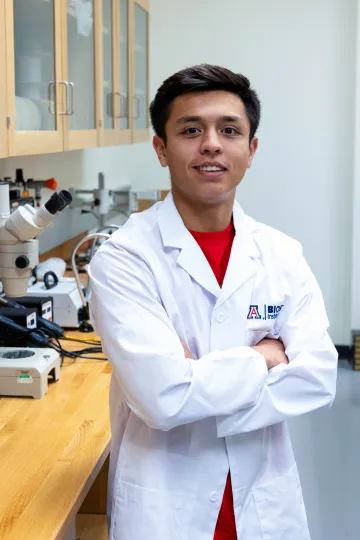
High School: Nogales High School
City: Rio Rico
Faculty Mentor: Dr. Kenneth Wilund
Research Project: Development of a Comprehensive Low Sodium Intervention for Hemodialysis Patients
One of the major causes of cardiovascular diseases in Hemodialysis patients (HD) is high intake of sodium. While HD patients are counseled to reduce their salt intake, it is very challenging to achieve. The purpose of this project is to develop a strategy to teach HD patients how to live a low-sodium lifestyle through growing plants, training for grocery shopping, and participating in cooking classes. Using these novel programs, we expect participating HD patients to see a distinct change in their quality of life. We hope this can serve as a template for changing the way nutritional information is provided to HD patients and benefits their health. Success will allow us to implement it in dialysis clinics around the community.
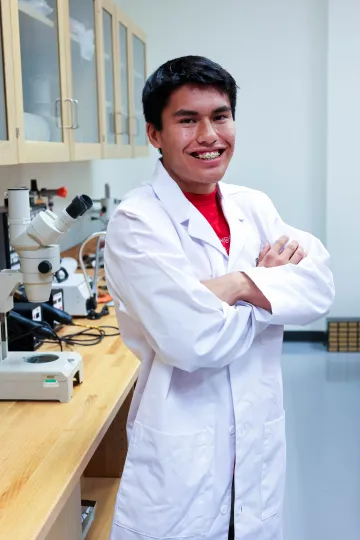
High School: University High School
City: Tucson
Faculty Mentor: Dr. Alicja Babst-Kostecka
Research Project: Assessing Copper Tolerance in Atriplex lentiformis and Atriplex canescens
Throughout the Desert Southwest, mining operations have left behind toxic metals and tailings in soils, contaminating environments and posing risks to life in the area. Most plants would be unable to survive in these polluted soils, however, plants called hyperaccumulators can tolerate these conditions, absorbing metals through their roots and storing them in their stems and leaves.¹ The focus of my research are two potential hyperaccumulators native to the Desert Southwest: Atriplex lentiformis and A. canescens In my experiment I am assessing how much copper they can tolerate to determine whether these plants are suitable to plant near mine sites. If suitable, they can reabsorb these toxic metals from the ground, remediating contaminated land and restoring it for other life.

High School: Mountain Ridge High School
City: Phoenix
Faculty Mentor: Dr. Gondy Leroy
Research Project: Use of All of Us Database in Examining Traumatic Brain Injuries in American Populations
Injuries within the elderly continue to grow for a variety of causes. An example of this is Traumatic Brain Injury (TBI). My lab’s goal was to perform a demographic analysis of those who get TBI accidentally or purposefully using the All of Us Data Browser, which contains millions of public health records donated by Americans. We looked at the general causes by creating filters for both the main causes of TBI. Results show that those who are white, female, and senior-aged are more likely to fall victim to accidental TBI, while those who are white or black, male, and between the ages of 45-64 are more likely to fall victim to purposeful TBI. These results highlight the need for targeted prevention strategies and interventions within these demographic groups in order to prevent future TBI.

High School: Arizona School for the Arts
City: Phoenix
Faculty Mentor: Dr. Lalitha Madhavan
Research Project: Effects of Lasmiditan on Mitochondrial Biogenesis and Alpha Synuclein expression in an aged Parkinson’s Disease Mouse Model
Parkinson’s disease (PD) is a common age-related neurodegenerative disorder. Mitochondrial dysfunction is known to be a core feature of PD. Thus, we hypothesized that inducing mitochondrial biogenesis (MB), the creation of new mitochondria, can intervene in PD progression. In this context, we tested the potential of Lasmiditan, an FDA approved drug known to induce mitochondrial biogenesis, in a PD mouse model. Our previous data, in young 4–6-month-old mice, showed that Lasmiditan increased MB and mitigated PD pathology. Here, we examined aged 10–12-month-old mice and found that Lasmiditan mildly increases mitochondrial DNA and a protein marker of MB. These data suggest that Lasmiditan may not be as effective in aged animals compared to younger mice.
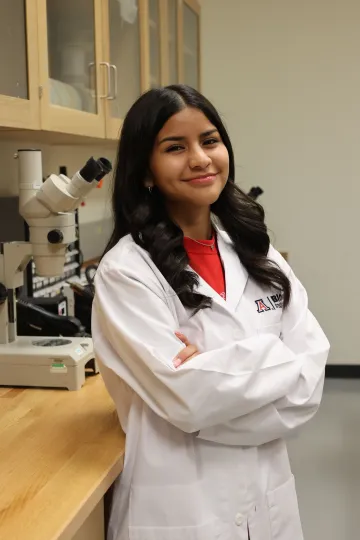
High School: Pueblo High School
City: Tucson
Faculty Mentor: Dr. Kirsten Limesand
Research Project: The Role of Yap in Dysfunctional Salivary Gland Cells
Radiotherapy induced dysfunction in the salivary glands leads to dry mouth, decreased salivary flow, and oral infections. Although short-term treatments are an option, the Limesand lab works to understand salivary gland dysfunction to implement permanent treatments. My project tested if the presence of Yap (yes-associated protein), which controls the multiplication of cells, affects the cytoskeletal structure responsible for transporting salivary protein. Using a stain that binds to the cytoskeleton, we were able to visualize the cytoskeletal area and compare Yap present cells to Yap absent cells that were not treated with radiotherapy. We found that Yap does not affect the cytoskeleton before treatment with radiotherapy. Our findings allow for treatment development through understanding how the dysfunction process works and how we can reverse or prevent it.
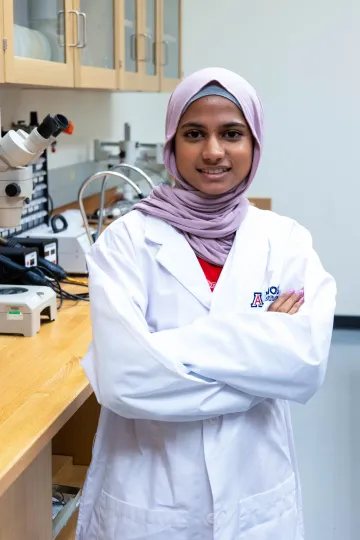
High School: BASIS Oro Valley
City: Tucson
Faculty Mentor: Dr. Jason Karnes
Research Project: Detecting the Association of Copy Number Variation on PHIP Gene with Dosing in Warfarin Treated Hispanic Population
Warfarin, a common blood thinner, is a leading cause of hospitalizations in the elderly due to adverse drug responses in the US (Budnitz, et al, 2011). Predicting effective treatment requires understanding dose requirements influenced by genetics and demographics. With limited reports on Hispanic/Latino dose requirements, my research is finding an association of copy number variations (CNVs) on our gene of interest (PHIP) and Warfarin dosing in the Hispanic/Latino population. CNVs are edits in DNA leading to varying DNA section repeats among individuals. We counted gene copies per sample, and analysis produced no association between CNVs in PHIP and Warfarin dose requirement. Highlighting the genomic role in dosing variability, my research contributes to precision medicine and clinical studies, particularly in cardiovascular fields.
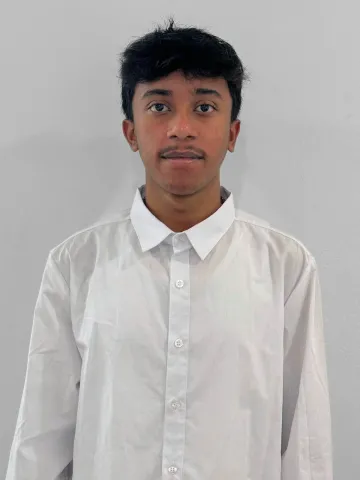
High School: Hamilton High School
City: Chandler
Faculty Mentor: Dr. Melville Wohlgemuth
Research Project: Rate of Bat Vocalizations in Various Environments
My research focuses on analyzing bat vocalization data to understand how vocalization rates change as bats approach prey in an open environment compared to a cluttered environment. Focusing on the Big Brown bat species, we used the microphone audio from open and closed environment trials to perform corrections to the unrecognized vocalizations and find patterns in their vocalization rates using the MatLab Data Processing Software. We found that when bats hunt in more cluttered environments, their vocalization rates are more rapid due to the increased need for precision when traveling. This research could reveal how bat vocalizations can vary in different habitats, providing more insights into their adaptive behaviors.
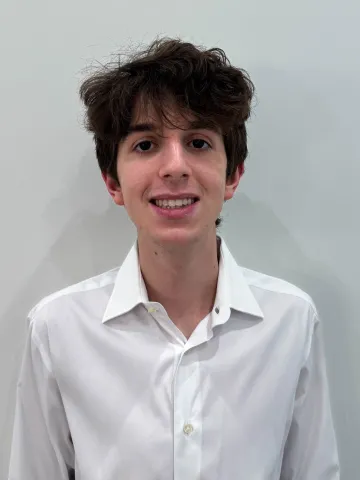
High School: Phoenix Country Day School
City: Paradise Valley
Faculty Mentor: Dr. Bonnie LaFleur
Research Project: The Role of Sleep and Cardiovascular Health in Cognitive Impairment
Studies have highlighted a direct correlation between reduced sleep quality and cognitive impairment, and between sleep deficiency and elevated cardiovascular disease risk. This research investigates whether sleep quality predicts cognitive function independent of cardiovascular health. To investigate this question, data was compiled from three large survey datasets—NACC, PAN, and ADNI. Variables representing sleep, cardiovascular disease, and cognitive impairment were created. Statistical analysis was conducted to determine the relationships among the three variables. Expected results would reinforce the association between sleep and cognitive impairment and between sleep and cardiovascular disease. Confirming these relationships could influence public health policies, emphasizing the importance of sleep quality in preventative healthcare strategies. This research could lead to interventions that enhance sleep quality, thus improving cognitive function and lowering cardiovascular risk.
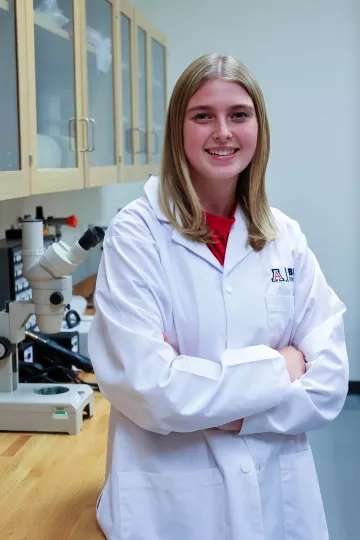
High School: Arcadia High School
City: Scottsdale
Faculty Mentor: Dr. Frank Duca
Research Project: Characterizing CCK-Activated Vagal Afferent Neurons in the TRAP2 Mouse Model
According to the Center for Disease Control, more than 20% of the US population was obese in 2022. This summer, I researched how a gut peptide, cholecystokinin (CCK), activates gut-brain neurons to limit food intake and weight gain in a mouse model. The regions of interest included a part of a gut-brain connecting nerve, the nodose ganglion, and a region in the brain, the nucleus tractus solitarius (NTS). As I sliced, stained, and examined images, I was determining if CCK-activated neurons appeared in these regions. In the end, we should see the expression of CCK in the mice. The information gained from this project can help researchers identify ways to control food intake and weight gain by focusing on gut-brain relationships in humans.

High School: BASIS Tucson North
City: Tucson
Faculty Mentor: Dr. Tai Kong
Research Project: Investigating C14 Polycrystal Magnets
In a heavily digitized and industrialized world, magnets are seen everywhere from cell phones to MRIs. High quality magnets are made of rare earth metals (REMs) which are expensive and mostly produced in foreign countries. My project investigates non-REM compounds of the C14 Laves phase structure. C14 compounds pack many atoms, contributing to possible ferromagnetic properties. We synthesized compounds of the eight compositions (Mo,W)2(Mn,Fe,Ni,Co)3Si. Finding the curie temperature of a ferromagnet characterizes possible high-temperature applications like high-output computing or rocket thrusters. As of this abstract, proper compounds have only been found in W2(Fe,Co)3Si and Mo2(Fe,Ni,Co)3Si and W2(Fe,Co)3Si have been measured. We expect similar curie temperatures across the compounds.
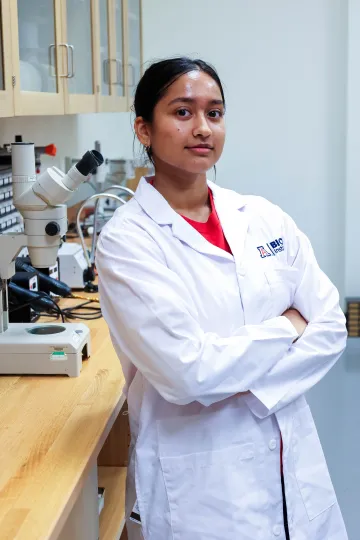
High School: BASIS Chandler
City: Chandler
Faculty Mentor: Dr. Malak Tfaily
Research Project: Characterization of Extremophilic Microbes
Extremophiles: organisms that thrive in extreme environments. We examined their application in a futuristic sense and in a medicinal sense. Martian Soil contains perchlorates that act as toxic bleach compounds making it difficult for microbes to survive. Similarly, snake venom contains toxins that have had detrimental effects on humans. I observed what extremophilic microbes could produce via filtering soil samples and extracting DNA from venom samples to gain the microbes’ biological components. We predict microbes in the soil samples to be able to use perchlorates to produce nutrients to grow plants, and we also aim to gain a better understanding of microbes in snake venom, so more effective antivenoms can be distributed.
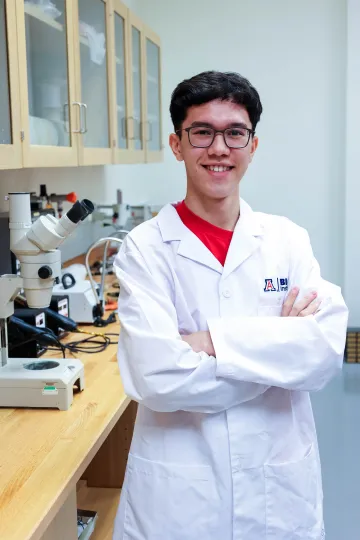
High School: Saguaro High School
City: Scottsdale
Faculty Mentor: Dr. Kyle Seyler
Research Project: Design, Fabrication, and Optical Characterization of Semiconductor Moiré Superlattices
Two-dimensional (2D) materials, which are atomically thin crystalline solids, exhibit unique electrical, magnetic, and optical properties. I investigated structures of stacked 2D materials that form a moiré pattern, focusing on their design, fabrication, and optical characterization. First, I reproduced the exfoliation of various 2D materials and optimized the temperature to pick up and stack these materials. Subsequently, I found and verified monolayer semiconductor samples to fabricate a bilayer moiré superlattice. I characterized the stack using photoluminescence (PL) spectroscopy, a technique that provides information about the optical properties and sample quality. The phenomena that emerge in moiré 2D materials have tremendous potential for next-generation electronic technologies, such as information processing, sensors, light-interactive technology, and small devices.
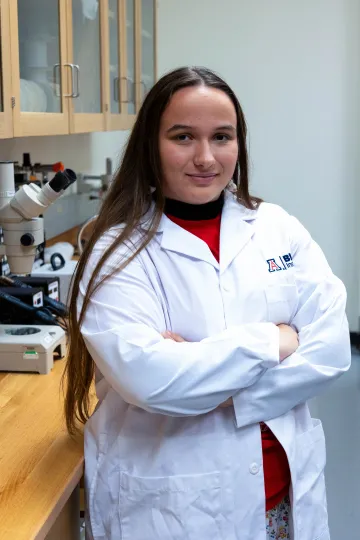
High School: Desert Vista High School
City: Phoenix
Faculty Mentor: Dr. Julie Ledford
Research Project: The Role of CC16 in Asthma and Therapeutic Discovery
CC16 is an anti-inflammatory protein produced in the distal airways. Low levels of it are associated with pulmonary diseases including asthma. Our first experiment investigated the differences between asthmatic and Wild Type mice using amplification and cell counting methods. We found that asthmatic mice had lower levels of CC16 and host defense factors compared to Wild Type mice. The second experiment looked at the use of a potential therapeutic (C836) in CC16 deficient mice using amplification, cell counting, and histology. With the therapeutic we observed reduced airway hyperresponsiveness and hypothesized that the drug’s effect would increase if administered through the vein, instead of by lung. The next step in this research will be to trial C836 intravenously in asthmatic mice
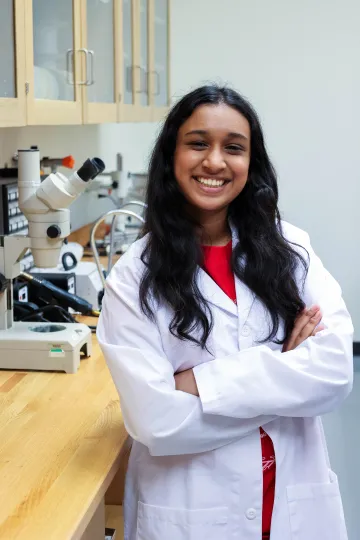
High School: BASIS Chandler
City: Chandler
Faculty Mentor: Dr. Nathan Ellis
Research Project: The Role of HJURP in Activating Homologous Recombination within the rDNA Locus for DNA Integrity Maintenance
Mutated or unrepaired DNA can cause cancer due to genomic instability. Generally, DNA is repaired in the final phase of cell replication; however, under special circumstances, it can be repaired during the growth phase. HJURP is a specific protein involved in DNA repair. We are investigating HJURP activity during the growth phase by analyzing its presence in damage-induced cells. We do this by inserting an enzyme to induce DNA breaks in cells, staining the cell’s organelles with antibodies, and imaging for the protein’s presence and repaired DNA underneath a microscope. We expect our results to show HJURP's presence, which would indicate a novel mechanism for maintaining undamaged DNA, providing insights for preventing cell death and uncontrolled growth, with potential implications for cancer research and therapy.

High School: Paradise Valley High School
City: Scottsdale
Faculty Mentor: Dr. Teodora Georgieva
Research Project: Comparing the Efficiency of Two CRISPR/Cas9 Delivery Methods for Gene Targeting in Human Cancer Cells
We used a gene editing method called CRISPR, which involves the Cas9 enzyme, to cut and remove DNA sections. There are multiple ways Cas9 can be brought into the cell, and we researched which of two different CRISPR methods is most effective at bringing Cas9 into the cell and deleting a gene. We tested this by either shocking cells to open pores in the membrane, or using lipids to bring Cas9 inside the cell, and our results showed the gene was deleted 1.8% and 1.6% of the time, respectively. We also added a drug that killed the untransformed cells, which increased the percentage to 31.6%. These results help show which CRISPR method is more effective at editing cell lines, producing better results.

High School: University High School
City: Tucson
Faculty Mentor: Dr. Molly Hunter
Research Project: Timing is Everything: Delayed Acquisition of the Bacterium Caballeronia Harms Gut Development in Leaf-Footed Bugs
Insect survival may depend on beneficial bacteria that supplement nutrition; most are passed directly from mother to offspring. However, the leaf-footed bug must find and ingest the bacterium Caballeronia from the environment each generation or face shorter lifespans and abnormal development. I researched how delaying the insect’s acquisition of Caballeronia past the ideal developmental stage impacts the development of bacteria-housing structures in the insect’s midgut called crypts. Insects were fed the bacteria at different intervals after the ideal developmental stage. Once they reached adulthood, their midguts were isolated and analyzed. We found that as the delay increased, the size of the crypts decreased, indicating that delayed bacteria acquisition limits midgut growth and impacts insect development. These results advance knowledge of animal gut-microbe interactions in general.

High School: Mountain Ridge High-school
City: Peoria
Faculty Mentor: Dr. Bonnie LaFleur
Research Project: What Causes Brain Function to Decline Quickly in the Elderly?
Dr. LaFleur's lab aims to understand how sleep duration impacts cognitive function in elderly individuals, with and without cardiovascular risks. I researched the Precision Aging Network (PAN) dataset, focusing on sleep problems, cardiovascular diseases, and cognitive function. Cognitive function was assessed using a test to classify patients as unimpaired or impaired. The sleep variable included patients with sleep-related issues, while the cardiovascular variable included those with heart disease, stroke, and/or hypertension. We conducted statistical tests to examine relationships between these variables. The results showed a significant relationship between sleep problems and cognitive decline, but cardiovascular diseases did not significantly affect cognitive decline. We hope our study will improve elderly healthcare and increase their healthspan.
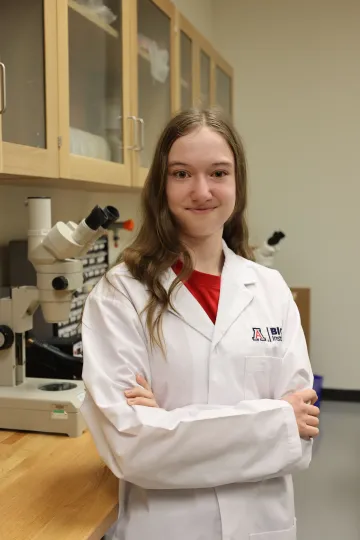
High School: Ironwood Ridge High School
City: Oro Valley
Faculty Mentor: Dr. Luciano Matzkin
Research Project: Creating a Behavioral Assay to Test Cactophilic Flies' Olfactory Response to Ectoparasites
Cactophilic flies in the Sonoran desert avoid ectoparasitic mites, Macrocheles subbadius. Previous work showed that Drosophila spp. detect and avoid toxic microbes and parasitoid wasps through smell, but it is unknown whether they use smell to avoid mites. I used egg-laying to measure mite avoidance in two cactophilic fly species, and tested several assay designs. For D. mojavensis, no-choice assays showed that flies in vials with the smell of mites laid fewer eggs, but the trend was not significant. For D. nigrospiracula, I designed a dyed-potato media diet that allowed measurement of egg-laying in choice assays, but egg-laying was not impacted by mite smell. Future research can use no-choice assays with D. nigrospiracula, using the new media recipe, to confirm mite avoidance in this species.

High School: Marana High School
City: Tucson
Faculty Mentor: Dr. Jennifer Andrews
Research Project: Autism Spectrum Disorder Prevalence Rates in Different Racial/Ethnic Groups
My project is focused on finding differences in Autism Spectrum Disorder (ASD) prevalence rates among racial and ethnic groups in 4- and 8-year-olds. ADDM masks their studies by grouping people who have Hispanic ethnicities. I analyzed prevalence rates from an unmasked study by the ADDM network in 2016. To research differences in prevalence among racial and ethnic groups — using a prevalence ratio equation, I calculated prevalence rates per 1,000 children. I found there are differences in the prevalence of ASD in various racial/ethnic groups; this research is beneficial because it brings a wider understanding of ASD and who it affects. My project can direct future research to explore the root cause of why certain racial/ethnic groups have higher prevalence rates.
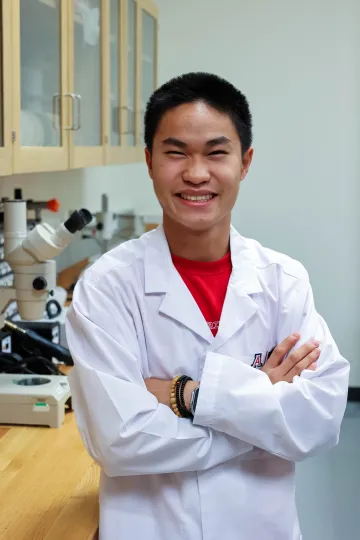
High School: University High School
City: Tucson
Faculty Mentor: Dr. Paulo Pires
Research Project: TRPML-1 Pathway to BK Channel Dysfunction in Alzheimer's
Alzheimer’s disease causes cognitive impairment and motor function loss and is projected to double in cases by 2060. Patients experience a lack of blood vessel expansion (vasodilation) caused by inhibition of big potassium (BK) channels of smooth muscle cells (SMCs). I performed calcium imaging on SMCs to determine whether or not TRPML-1, an ion channel on the high calcium concentrated lysosome, was a factor in the lack of calcium sparks that is responsible for BK channel activation. We predict that overexpressed TRPML-1 will lead us to see more calcium sparks, allowing for vasodilation. This research will allow us to target activation of TRPML-1 in male patients in hopes of counteracting the effects of Alzheimer’s.


